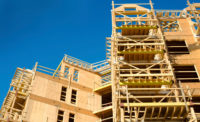Construction expenditures in China are expected to rise 8.5% per year in real terms through 2017, according to a new report from The Freedonia Group Inc. Ongoing urbanization and industrialization, rising income levels, further population and household growth, as well as the government’s continuing efforts to expand and upgrade physical infrastructure in the country, are expected to support healthy growth in construction spending. However, growth will moderate notably from the 16% annual gains during the 2007-2012 period, when gross fixed capital formation was boosted by the government’s stimulus program to counter the global financial crisis in 2009. This program ended in 2011, and increases in construction spending (along with fixed investment) will see a significant slowdown.
Construction expenditures in China are nearly equally split among residential buildings, nonresidential buildings and nonbuilding structures. Each of these segments accounted for around one-third of the total construction market in 2012. Nonbuilding construction will see the fastest growth, advancing 9.2% annually in real terms through 2017. Increases will benefit from state-led efforts to expand and upgrade the country’s transportation infrastructure. Utilities construction will also contribute to nonbuilding construction spending gains, particularly in fast-growing urban areas, as the government continues to expand and improve access to such infrastructure as water supply, sewage treatment, garbage disposal, and gas distribution. Additional efforts to increase the country’s power generation capacity and improve electricity transmission networks will also drive spending on nonbuilding construction in China through the forecast period.
Inflation-adjusted nonresidential building construction expenditures are forecast to rise 8.4% per year through 2017. Growth will reportedly be led by strong gains in industrial building construction. The manufacturing sector in China will continue to expand quickly, benefiting from robust increases in consumer spending for manufactured goods, accommodative government policies, and foreign direct investment. Spending on residential buildings is projected to grow at an annual pace of 8% in real terms through 2017. Market gains will be primarily driven by continuing population migration from rural to urban areas and supported by rising personal income levels.
For additional information, visit www.freedoniagroup.com.


